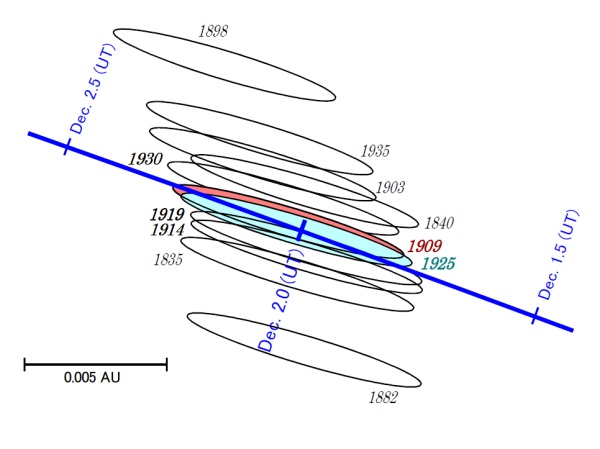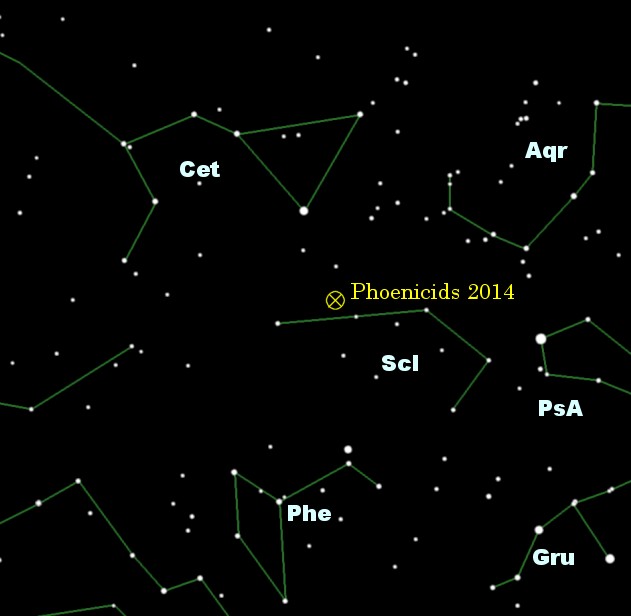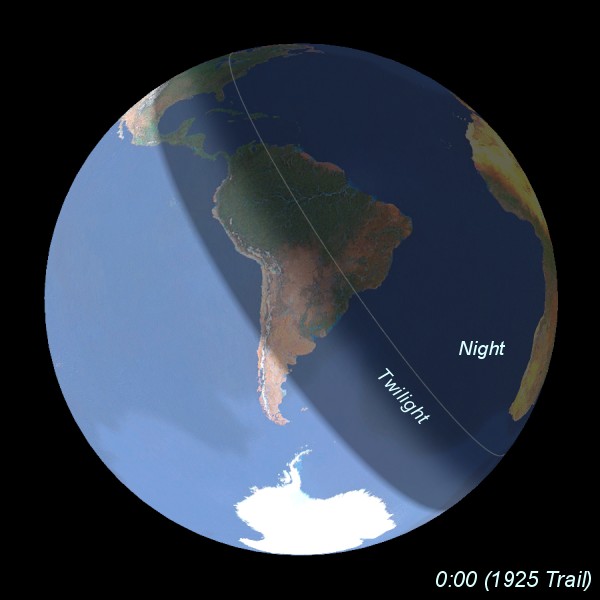Phoenicids 2014
Phoenicids (PHO ; #254) is one of the established meteor showers. However, a spectacular Phoenicids display was recorded only once, on 1956 December 5.
In 2014, the possibility of enhanced Phoenicids shower is expected since several dust trails will approach the Earth on December 1.
Updates : Dec. 10 (Open : Oct. 12)
Phoenicids meteor shower was detected on Dec. 1-2.
 Time : 00h47m (UT).
Time : 00h47m (UT).
Photo by Mikiya Sato at La Palma.
We went to La Palma island of Islas Canarias to observed Phoenicids. And, we succeeded in detection of the Phoenicids meteor shower since the outburst of last 1956. Its Hourly Rate recorded 12 at 1:00 UT on Dec 2 (6 meteors per 30 minutes) as a quick reprot. We could not observe before 0:30 UT because of cloudy sky. But it became clear at 0:30 and I could do it.
Dr. Junji Nakamura who discovered last Phoenicids outburst in 1956 watched the second Phoenicids meteors at La Palma since then. (He is 91 years old!)
Japanese other team visited in the eastern part of US. They also detected Phoenicids and recorded some meteors on photos and videos.
Furthermore, the possible phoenicids meteors were observed in parts of the world. I want to be gathering it. (But I am very busy now, sorry.)
Background
Phoenicids suddenly appeared on 1956 December 5, which had been an unknown meteor shower until then. J. Nakamura observed this outburst on a Japanese expedition ship, Soya, in the Indian Ocean on the way to the Antarctic while he was operating instruments for airglow observations. Nakamura reported that the activity was thought to have a maximum of about 300 in the visual hourly rate (Huruhata & Nakamura 1957). Other observations were summerised were summarized by G. W. Kronk (web).
The parent body of Phoenicids is 289P/Blanpain (D/1819W1 = 2003WY25). However, this comet had not been observed after discovery year of 1819. This object was rediscoverd as a new asteroid 2003 WY25. Recently, weak cometary activity was observed (Jewitt 2006, Williams 2013).
By decision of the parent orbit by rediscovery, the simulation by using a dust trail model became possible. Watanabe, Sato, & Kasuga (2005) reported that the enhanced activity of Phoenicids in 1956 was brought by dust trail formed by dust ejected between 1760 and 1814. Jenniskens & Lyytinen (2005) also reported a similar result.
Moreover, Sato & Watanabe (2010) found three chances of Phoenicids appearance, in 2008, 2014 and 2019 by simulation of dust trail model. The situation in 2014 is a most expectable chance.
Situation in 2014
In 2014, Phoenicids meteor shower is highly expected due to ideal conditions for the dust trails formed at several perihelion passages in the early 20th century (Sato & Watanabe 2010). Table 1 shows data of main trails which approach the Earth in 2014.
The peak time is forecasted to be between 23:00 on Dec. 1 and 1:00 on Dec. 2. Each peak will be not sharp because the values of the orbit inclinations are very low. Therefore, whole peak time will be continuous.
Table 1 Data of the main trails in 2014
Ejection
Year | Date
(UT) | Time
(UT) | Sol. Long.
(2000.0) | Delta-R
(AU) | Ejection
Velocity
(m/s) | fM | Radiant | Vg
(km/s) |
| R.A. | Dec. |
|---|
| 1914 | Dec. 01.96 | 23:03 | 249.472 | -0.00094 | -1.24 | 0.016 | 7.89 deg.
(00h31m35s) | -27.25 deg. | 9.79 |
| 1919 | Dec. 01.97 | 23:15 | 249.480 | -0.00070 | -1.98 | 0.026 | 7.91 deg.
(00h31m38s) | -27.27 deg. | 9.78 |
| 1925 | Dec. 02.00 | 23:59 | 249.511 | -0.00020 | -2.33 | 0.030 | 7.94 deg.
(00h31m45s) | -27.36 deg. | 9.77 |
| 1909 | Dec. 02.02 | 00:27 | 249.531 | -0.000037 | -1.74 | 0.022 | 7.98 deg.
(00h31m55s) | -27.49 deg. | 9.78 |
| 1930 | Dec. 02.05 | 01:07 | 249.559 | +0.00064 | -2.94 | 0.036 | 7.99 deg.
(00h31m58s) | -27.52 deg. | 9.76 |
These data are calculated newly.

Fig. 1 Distribution of the main trails in 2014
Activity
Huruhata & Nakamura (1957) reported that the activity of Phoenicids in 1956 leached 300 as the hourly rate (HR). The condition in 2014 is similar to one in 1956, however, the whole value of fM in 2014 is about half as large as that in 1956. Therefore, the highest activity is expected to be about 150 (HR) in 2014. Moreober, this meteor activity will become smaller if the cometary activity of a parent body in the early 20th century was weak.
That means, the cometary activity of a parent body of those days can be presumed by observing the meteor activity this year. Observing Phoenicids this year is very significant.
Radiant
In case of 2014, the radiant of Phoenicids is located in Sculptor. The position will be the north side from that time of 1956. In addition, the radiant will be wide in the direction of the zenith because of a low velocity. It may be observed also in the area of the Northern Hemisphere.

Location
At the peak time (0:00), the area which can be observed is a night area as in the following figures.
A good area of the observation condition is the Atlantic and the eastern part of the South America. We can also observe in the western part of Africa and the northeast part of North America.
We are planning the observation at La Palma in the Canary Islands. We can observe until the peak time. Other team is planing the observation at the east of USA.
Furthermore, Phoenicids shower may be able to be seen in a large area because the peak will be continuous. We hope more observations.

References
Our Team's
-
Sato & Watanabe 2010, PASJ (Publications of the Astronomical Society of Japan), Vol 62, No.3, pp.509-513.
"Forecast for Phoenicids in 2008, 2014, and 2019"
ADS Site | PDF File
-
Watanabe, Sato, & Kasuga 2005, PASJ (Publications of the Astronomical Society of Japan), Vol 57, No.5, pp. L45-L49.
"Phoenicids in 1956 Revisited"
ADS Site | PDF File
Others
-
Huruhata & Nakamura 1957, Tokyo Astron. Bull., 2nd Ser., No. 99.
-
Jenniskens & Lyytinen 2005, The Astronomical Journal, Vol 130, Issue 3, pp.1286-1290.
-
Jewitt 2006, The Astronomical Journal, Vol 131, Issue 4, pp.2327-2331.
-
Williams et al. 2013, Central Bureau Electronic Telegrams, 3574, 1.
Mail to Mikiya Sato
Mikiya Sato (Kawasaki Municipal Science Museum)
Copyright(C) 2014- Mikiya Sato..




